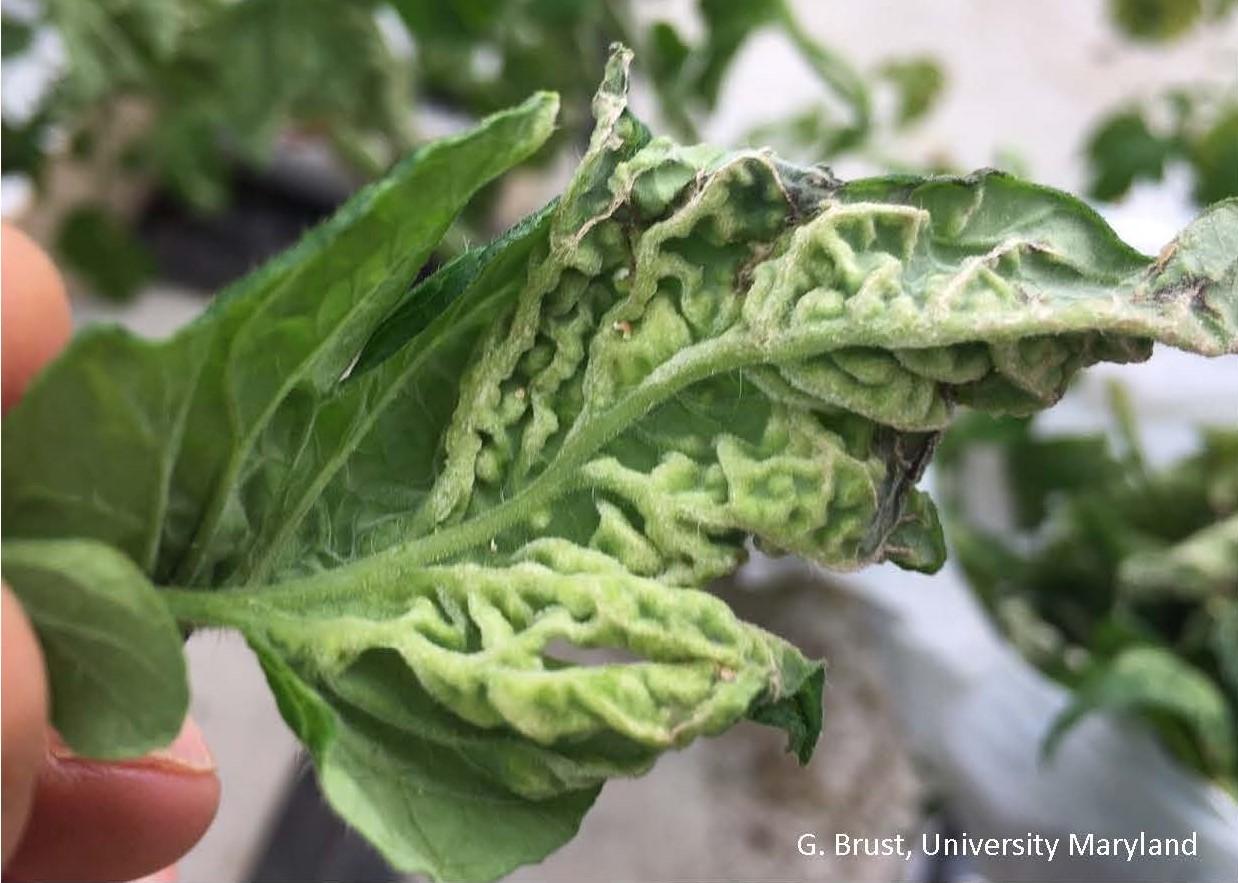An odd problem was seen in tomato plants being grown for harvest in a greenhouse that showed blister- or callus-like growths usually along veins that first appeared on the underside of older leaves (fig. 1). Leaves also showed unusual curling and other odd distortions on the top side of the leaf (fig. 2). In addition there can be spots of necrotic leaf tissue. Leaves with a great deal of this blistering were brittle with the leaf often cracking with any type of handling. These symptoms are edema (or sometimes spelled oedema). Edema is caused by the buildup of excess water in the root and conditions unfavorable for transpiration, usually caused by high humidity. When the tomato plant cells get too much water the cells will expand faster than they can get rid of the water leading to split and cracked tissue. Extensive edema can severely decrease the leaf’s photosynthetic capability and lead to senescence. Other research has looked at poor or low light sources that affect the plants ability to expel excess water. So basically overwatering, high humidity and low or poor light are the major causes for the development of edema. Therefore, avoid overwatering plants in the greenhouse especially during cool temperatures when they should be kept slightly on the dry side. Keep humidity levels below 70% by enhancing airflow around the plants and by spacing the plants farther apart. Though more complicated, research has shown that increasing light quality by providing a more “full-spectrum” of light output, with significantly more short wavelength energy (i.e., UV light), will also decrease the occurrence of edema.


Return to Horticulture and Disease Topics
This article appears on May 13, 2021, Volume 12, Issue 2 of the Vegetable and Fruit News
Vegetable and Fruit News, May 2021, Vol. 12, Issue 2
Vegetable and Fruit News is a statewide publication for the commercial vegetable and fruit industries and is published monthly during the growing season (April through October). Subscribers will receive an email with the latest edition.
Subscribe
 English
English العربية
العربية Български
Български 简体中文
简体中文 繁體中文
繁體中文 Hrvatski
Hrvatski Čeština
Čeština Dansk
Dansk Nederlands
Nederlands Suomi
Suomi Français
Français Deutsch
Deutsch Ελληνικά
Ελληνικά हिन्दी
हिन्दी Italiano
Italiano 日本語
日本語 한국어
한국어 Norsk bokmål
Norsk bokmål Polski
Polski Português
Português Română
Română Русский
Русский Español
Español Svenska
Svenska Català
Català Filipino
Filipino עִבְרִית
עִבְרִית Bahasa Indonesia
Bahasa Indonesia Latviešu valoda
Latviešu valoda Lietuvių kalba
Lietuvių kalba Српски језик
Српски језик Slovenčina
Slovenčina Slovenščina
Slovenščina Українська
Українська Tiếng Việt
Tiếng Việt Shqip
Shqip Eesti
Eesti Galego
Galego Magyar
Magyar Maltese
Maltese ไทย
ไทย Türkçe
Türkçe فارسی
فارسی Afrikaans
Afrikaans Bahasa Melayu
Bahasa Melayu Kiswahili
Kiswahili Gaeilge
Gaeilge Cymraeg
Cymraeg Беларуская мова
Беларуская мова Íslenska
Íslenska Македонски јазик
Македонски јазик יידיש
יידיש Հայերեն
Հայերեն Azərbaycan dili
Azərbaycan dili Euskara
Euskara ქართული
ქართული Kreyol ayisyen
Kreyol ayisyen اردو
اردو বাংলা
বাংলা Bosanski
Bosanski Cebuano
Cebuano Esperanto
Esperanto ગુજરાતી
ગુજરાતી Harshen Hausa
Harshen Hausa Hmong
Hmong Igbo
Igbo Basa Jawa
Basa Jawa ಕನ್ನಡ
ಕನ್ನಡ ភាសាខ្មែរ
ភាសាខ្មែរ ພາສາລາວ
ພາສາລາວ Latin
Latin Te Reo Māori
Te Reo Māori मराठी
मराठी Монгол
Монгол नेपाली
नेपाली ਪੰਜਾਬੀ
ਪੰਜਾਬੀ Afsoomaali
Afsoomaali தமிழ்
தமிழ் తెలుగు
తెలుగు Yorùbá
Yorùbá Zulu
Zulu ဗမာစာ
ဗမာစာ Chichewa
Chichewa Қазақ тілі
Қазақ тілі Malagasy
Malagasy മലയാളം
മലയാളം සිංහල
සිංහල Sesotho
Sesotho Basa Sunda
Basa Sunda Тоҷикӣ
Тоҷикӣ O‘zbekcha
O‘zbekcha አማርኛ
አማርኛ Corsu
Corsu Ōlelo Hawaiʻi
Ōlelo Hawaiʻi كوردی
كوردی Кыргызча
Кыргызча Lëtzebuergesch
Lëtzebuergesch پښتو
پښتو Samoan
Samoan Gàidhlig
Gàidhlig Shona
Shona سنڌي
سنڌي Frysk
Frysk isiXhosa
isiXhosa